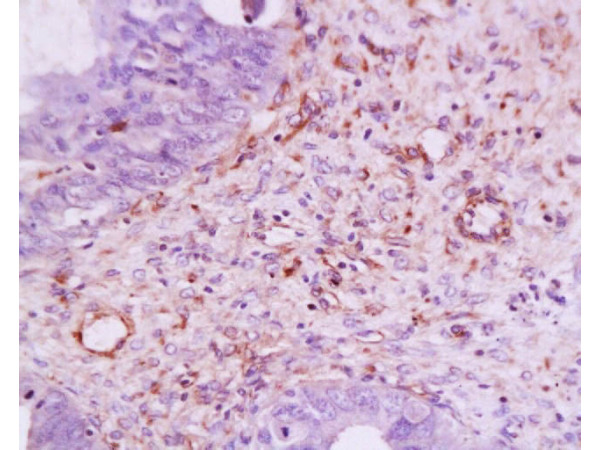VEGFA antibody
GTX102643
ApplicationsWestern Blot, ELISA, ImmunoHistoChemistry, ImmunoHistoChemistry Paraffin
Product group Antibodies
TargetVEGFA
Overview
- SupplierGeneTex
- Product NameVEGFA antibody
- Delivery Days Customer9
- Application Supplier NoteWB: 1:500-1:3000. IHC-P: 1:100-1:1000. *Optimal dilutions/concentrations should be determined by the researcher.Not tested in other applications.
- ApplicationsWestern Blot, ELISA, ImmunoHistoChemistry, ImmunoHistoChemistry Paraffin
- CertificationResearch Use Only
- ClonalityPolyclonal
- Concentration0.17 mg/ml
- ConjugateUnconjugated
- Gene ID7422
- Target nameVEGFA
- Target descriptionvascular endothelial growth factor A
- Target synonymsL-VEGF, MVCD1, VEGF, VPF, vascular endothelial growth factor A, long form, vascular endothelial growth factor A121, vascular endothelial growth factor A165, vascular permeability factor
- HostRabbit
- IsotypeIgG
- Protein IDP15692
- Protein NameVascular endothelial growth factor A, long form
- Scientific DescriptionThis gene is a member of the PDGF/VEGF growth factor family. It encodes a heparin-binding protein, which exists as a disulfide-linked homodimer. This growth factor induces proliferation and migration of vascular endothelial cells, and is essential for both physiological and pathological angiogenesis. Disruption of this gene in mice resulted in abnormal embryonic blood vessel formation. This gene is upregulated in many known tumors and its expression is correlated with tumor stage and progression. Elevated levels of this protein are found in patients with POEMS syndrome, also known as Crow-Fukase syndrome. Allelic variants of this gene have been associated with microvascular complications of diabetes 1 (MVCD1) and atherosclerosis. Alternatively spliced transcript variants encoding different isoforms have been described. There is also evidence for alternative translation initiation from upstream non-AUG (CUG) codons resulting in additional isoforms. A recent study showed that a C-terminally extended isoform is produced by use of an alternative in-frame translation termination codon via a stop codon readthrough mechanism, and that this isoform is antiangiogenic. Expression of some isoforms derived from the AUG start codon is regulated by a small upstream open reading frame, which is located within an internal ribosome entry site. [provided by RefSeq, Nov 2015]
- Storage Instruction-20°C or -80°C,2°C to 8°C
- UNSPSC12352203
References
- Fukumoto W, Yoshino H, Horike SI, et al. Potential therapeutic target secretogranin II might cooperate with hypoxia-inducible factor 1α in sunitinib-resistant renal cell carcinoma. Cancer Sci. 2023,114(10):3946-3956. doi: 10.1111/cas.15914Read this paper
- Park M, Shin HA, Duong VA, et al. The Role of Extracellular Vesicles in Optic Nerve Injury: Neuroprotection and Mitochondrial Homeostasis. Cells. 2022,11(23). doi: 10.3390/cells11233720Read this paper
- Lin YC, Huang YL, Wang MH, et al. Calreticulin Regulates β1-Integrin mRNA Stability in PC-3 Prostate Cancer Cells. Biomedicines. 2022,10(3). doi: 10.3390/biomedicines10030646Read this paper
- Tsai CW, Tsai SJ, Pan YJ, et al. Transcranial Ultrasound Stimulation Reverses Behavior Changes and the Expression of Calcium-Binding Protein in a Rodent Model of Schizophrenia. Neurotherapeutics. 2022,19(2):649-659. doi: 10.1007/s13311-022-01195-xRead this paper
- Cheng YH, Tsai NC, Chen YJ, et al. Extracorporeal Shock Wave Therapy Combined with Platelet-Rich Plasma during Preventive and Therapeutic Stages of Intrauterine Adhesion in a Rat Model. Biomedicines. 2022,10(2). doi: 10.3390/biomedicines10020476Read this paper
- Lin Y, Dong S, Ye X, et al. Synergistic regenerative therapy of thin endometrium by human placenta-derived mesenchymal stem cells encapsulated within hyaluronic acid hydrogels. Stem Cell Res Ther. 2022,13(1):66. doi: 10.1186/s13287-022-02717-2Read this paper
- El-Sherbiny M, El-Sayed RM, Helal MA, et al. Nifuroxazide Mitigates Angiogenesis in Ehlrich's Solid Carcinoma: Molecular Docking, Bioinformatic and Experimental Studies on Inhibition of Il-6/Jak2/Stat3 Signaling. Molecules. 2021,26(22). doi: 10.3390/molecules26226858Read this paper
- Park M, Kim HM, Shin HA, et al. Human Pluripotent Stem Cell-Derived Neural Progenitor Cells Promote Retinal Ganglion Cell Survival and Axon Recovery in an Optic Nerve Compression Animal Model. Int J Mol Sci. 2021,22(22). doi: 10.3390/ijms222212529Read this paper
- He M, Long P, Chen T, et al. ALDH2/SIRT1 Contributes to Type 1 and Type 2 Diabetes-Induced Retinopathy through Depressing Oxidative Stress. Oxid Med Cell Longev. 2021,2021:1641717. doi: 10.1155/2021/1641717Read this paper
- Wang Y, Tan X, Wu Y, et al. Hsa_circ_0002062 Promotes the Proliferation of Pulmonary Artery Smooth Muscle Cells by Regulating the Hsa-miR-942-5p/CDK6 Signaling Pathway. Front Genet. 2021,12:673229. doi: 10.3389/fgene.2021.673229Read this paper







